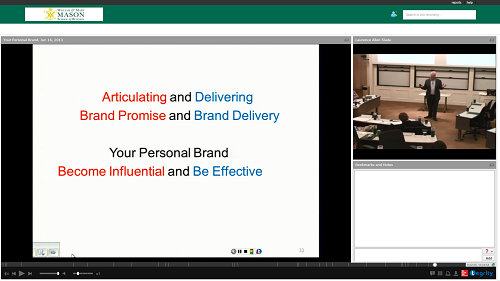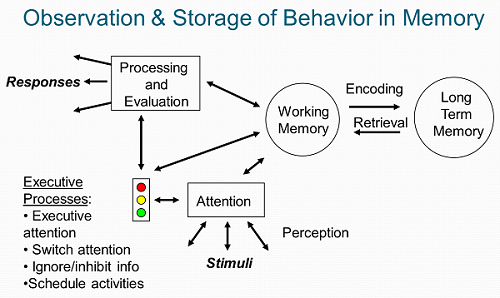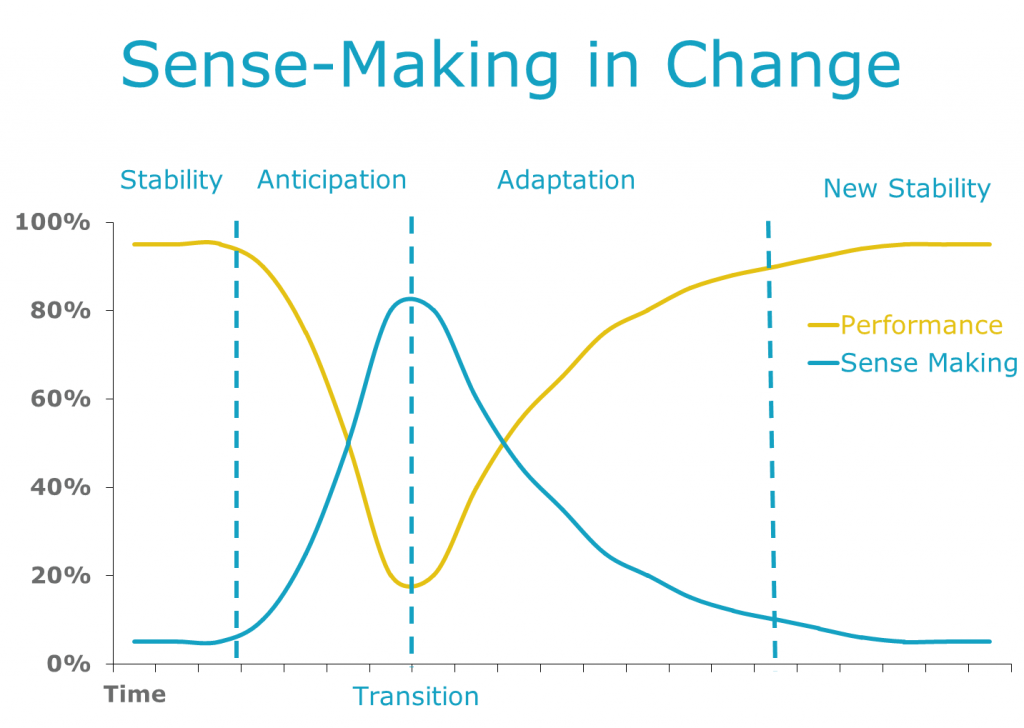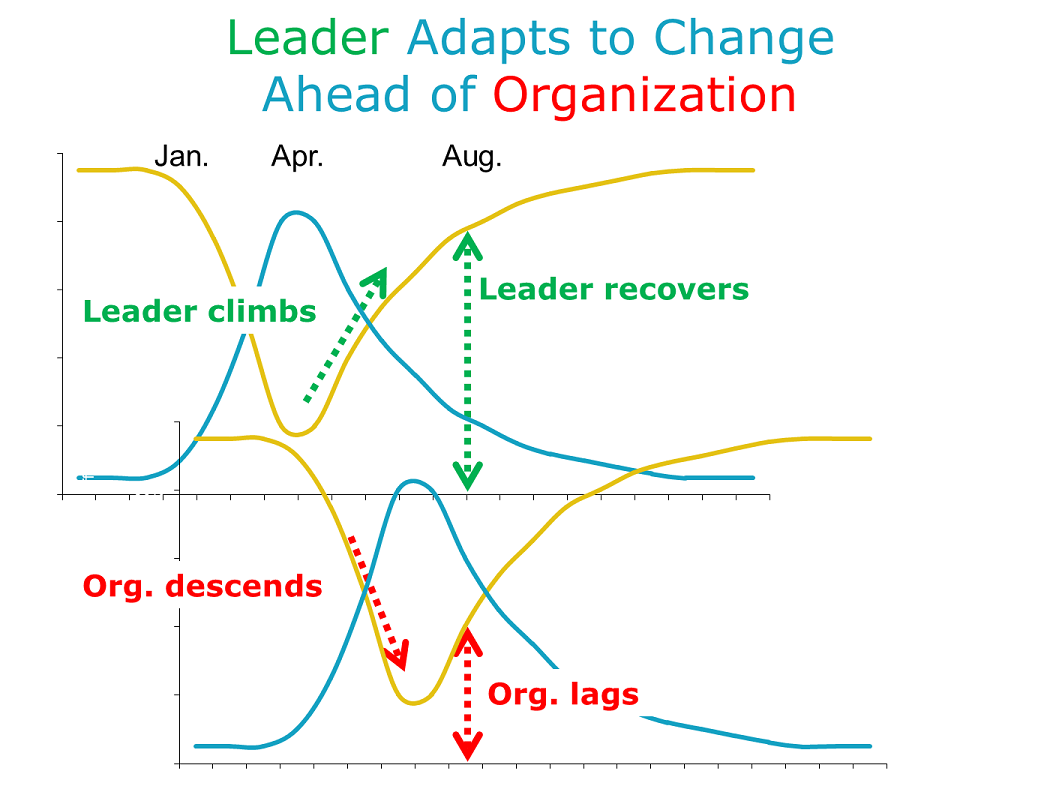When you walk in the room, who shows up for Read more →

Developing Your Personal Brand
When you walk in the room, who shows up for the other people? Is how you perceive yourself the same as how others perceive you? In this 35 minute video, Allen Slade shows how to develop a personal brand strategy so you can become influential and be effective.
What’s Your Best Alternative to Negotiating?
In a failed attempt to lean in, W., an anonymous woman with a Ph.D. in philosophy, asked to negotiate better terms of employment at Nazareth College. Unfortunately, she had her job offer unilaterally rescinded. Many bloggers have commented on why this happened, ranging from gender bias by the college to narcissism and cognitive errors by the candidate.
Here’s another way to look at the situation: The job market is ripe with people who have a Ph.D. in philosophy. Nazareth College probably had a backlog of candidates with similar credentials. Passing over W. was an easy decision. In other words, the college had a BATNA – a “best alternative to a negotiated agreement“.
Negotiating With a BATNA
Negotiation is a dance of offers and counteroffers. With a BATNA, you can choose to sit out the dance. You have acceptable options, so you are not forced to reach a agreement with this employer, job candidate, supplier or customer. You can negotiate from a position of strength.
The employer’s perspective. As a hiring manager at Ford Motor Company, whenever I posted an opening, I would receive a stack of resumes. After the HR department pre-qualified the candidates, I might have 100 resumes left. I would quickly discard most of the resumes, then carefully review 10 or 15 resumes before calling a handful of worthy of candidates. I never negotiated starting salary or benefits. If a candidate asked to negotiate, I would have gone to the next person on my list. My BATNA was a large, diverse and desirable pool of candidates, so there was no reason to negotiate.
The job candidate’s perspective. It is best to interview when you already have a job. Then, your BATNA is to stay where you are. If you don’t have a job, try to generate multiple job offers that overlap. When I decided to move back home to Virginia, I still had a tenured faculty position at my previous college. I interviewed aggressively and received four separate job offers. I always kept one job offer “live” until I received a better offer. I eventually accepted an offer at a prestigious college 30 miles from where I grew up.
Negotiating Without a BATNA
If you really have no BATNA, you have no bargaining power. If you must have that blue 1968 Shelby GT 500 on the auction block, expect to pay top dollar. If there is only one acceptable job candidate, expect to pay top salary. If you are desperate for a job, expect to take whatever they offer.
Here is how to negotiate without a BATNA: Act confident, like you have a BATNA. And the best way to be confident is to find your hidden BATNA.
The employer’s perspective. As a hiring manager at Microsoft, I was looking for someone special – big data expertise, specific programming languages, HR business partner perspective and a willingness to live in the drizzle of Redmond. I opened a hiring requisition, but no acceptable candidates were found. Despite having the requisition open for months, I never even interviewed anyone. I preferred to leave the job unfilled (my hidden BATNA) than to hire someone without the full set of skills I needed. I was confident in my own capacity and the flexibility of my team to succeed, even if we had an empty box on the org chart.
Employers always have the BATNA of leaving a position open. A bad hire leads to poor performance and can create a drag on the rest of your team. You never “have” to hire anyone.
The job candidate’s perspective. As a job candidate, you always have alternatives – hidden BATNAs. I have been known to say “I would rather live in a refrigerator box than do that job.” For graduating students, the alternative to a professional job might be working for minimum wage or going to graduate school.
Whether or not the refrigerator box/Starbucks/grad school is a realistic alternative, confidently acting like you have a BATNA makes you more attractive. I once had a job interview over lunch. While glancing at the menu, the hiring manager started listing his expectations for my work schedule. I told him the schedule was a deal breaker. He insisted that all jobs in our field would have a similar schedule. I confidently disagreed, then selected my entrée. I enjoyed our lunch. Within a month, I interviewed elsewhere (with confidence) and got the job I wanted.
Why did W. go public in her failed negotiations with Nazareth College? In the firestorm after the original post, W. said “I asked for a less then 20% increase in salary [at Nazareth College]. When I negotiated for another tenure track offer in philosophy I asked for a more than 20% increase in salary and was offered it [emphasis mine].” If the other offer was still on the table when she negotiated with Nazareth College, she had a BATNA – as every job candidate and hiring manager should.
Know your BATNA or find a hidden BATNA to give yourself more negotiation power. And, if you truly don’t have a BATNA, smile and say, “Why yes! Thank you!” to your only choice.
Jobseekers, Brand Yourself as a Servant
Allen Slade
In cover letters, resumes and interviews, jobseekers often give reasons that they want or need a job. “I am seeking a rewarding career in . . . .” “I enjoy . . . .” “I would like to apply for your opening in . . . .” “I am reentering the workforce after . . . .” While these phrases are not illegal, immoral or ungrammatical, they are a bit self-centered.
Career success does not flow from your needs alone. You will be hired to serve, not to be served. You will succeed when your interests and abilities line up with the organization’s needs. The sweet spot for your career is when ability, affinity and opportunity meet.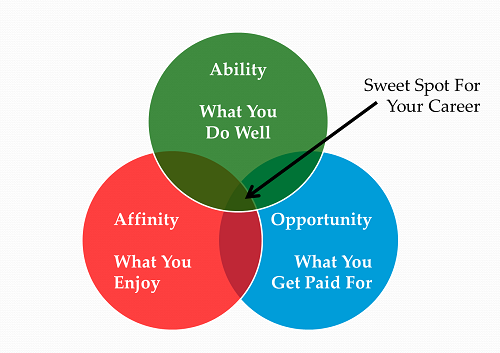
Hiring manager focus on the intersection of the green and blue circles. For hiring managers, affinity is a lesser priority than your ability to do the job. They want your competencies, capacities and commitments to solve their problems.
So, how do you shape a hiring manager’s perception of your ability to do the job? Managers quickly form an impression who you based on incomplete information. As I posted in The Problem with Your Personal Brand:
When you walk through the door, who shows up for the other people in the room? What image do people have of you? When I walk in, I would like to think that the “real” me shows up. Unfortunately, who actually shows up is an imperfect memory of me. . . . If only a partial image of the “real” you shows up when you walk in the room, you need a brand and a plan. You need a personal brand statement like this:
For [a specific person or group], I want to be known for [six adjectives] so I can deliver [valuable outcomes].
Bottom line: When seeking a job, brand youself as a servant. Hiring managers care about your ability to deliver valuable outcomes.
I advise my career coaching clients to take three steps before every job application:
1. Research. Investiage every job thoroughly before you apply. Go beyond studying the industry and the position itself. Figure out what problems keep the hiring manager awake at night.
2. Target your brand. Figure out the six adjectives that accurately describe your competencies, capacities and commitments to help solve those problems.
3. Articulate your brand. Then, craft your application and your interview responses to give a powerful brand message: Hire me and I will help solve your problems.
If you take these three steps, the hiring manager will be favorably inclined to pursue you as a candidate. And, you are likely to get the career outcomes you seek – meaningful work, concrete rewards, an opportunity to grow – because you are serving the organization well.
The Problem with Your Personal Brand
Allen Slade
When you walk through the door, who shows up for the other people in the room? What image do people have of you? When I walk in, I would like to think that the “real” me shows up. Unfortunately, who actually shows up is an imperfect memory of me. Here’s a picture of the cognitive process of what people remember about you:
Bottom line: The problem with your personal brand is every step of cognition simplifies and distorts the memory of who you are. As Leonardo DiCaprio’s character in the movie Inception says: “But I can’t imagine you with all your complexity, all your perfection, all your imperfection.”
If only a partial image of the “real” you shows up when you walk in the room, you need a brand and a plan. You need a personal brand statement like this:
For [a specific person or group], I want to be known for [six adjectives] so I can deliver [valuable outcomes].
For example, here is part of my own personal brand statement:
For my leadership coaching clients, I bring powerful listening, insightful curiosity and straightforward knowledge to create maximum leadership presence, personal effectiveness and organizational success.
Here are some suggestions on how to craft your own personal brand statement:
Target your brand. You should have a targeted personal brand statement for each group or person you want to impact. For myself, I have three brand statements. You need at least two brand statements.
Be organized. Gather all the data about how others perceive you – performance reviews, personality profiles, 360 feedback, key emails, verbal impressions, etc. Then take at least four hours spread over several days to draft your personal brand statement. Here is a personal brand worksheet to help you get started on defining your own personal brand statement.
Be authentic. Make sure your personal brand is completely compatible with the real you. Being authentic moves your personal brand from false advertising to true marketing. If your personal brand promises what you can actually deliver, you and the people you serve will be happier.
Get feedback. Once you have a draft of your personal brand statement, share it with your circle of trusted advisors. Their reaction to your brand can help you test its authenticity and its value to the people you want to serve. Your circle of trusted advisors should include mentors, spiritual advisors and, ideally, a certified career coach, leadership coach or executive coach.
When you craft a personal brand statement, you help focus the impressions others hold about you. You open doors to new leadership and career opportunities. Then, when you walk in the room, “who shows up” for the other people is the authentically influential you.
What to Expect from Career Coaching
Allen Slade
How can you find your dream job? Professional golfers, Olympic athletes and leaders all use coaches to maximize their performance. To accelerate your career success, consider adding a career coach to your search strategy.
Work takes up half your waking hours. If work is not going well – a toxic boss, a dead-end job, unemployment or underemployment – life tends to follow. In a booming labor market, new jobs are low hanging fruit. But in our current economy, you need a ladder to pick the apples at the top of the tree. You need a career coach.
A career coach is more effective than a teacher or mentor at stretching you to your best self. Your coach assumes you are the expert on your own career. Your coach will help you create a career plan and pursue opportunities effectively. And, a career coach will help you hold yourself accountable for meeting your career goals.
With my clients, we usually start with the ability, affinity and opportunity that make up their dream job.
Balancing ability, affinity and opportunity leads to long-term career success. If you focus on getting the highest paying job by matching your abilities with your opportunities and you ignore what you enjoy, you could end up in a dull job. If your focus on doing what you enjoy and do well, you could end up chasing disappearing opportunities with low pay, such as in the newspaper industry. If you focus only on high paying jobs you would enjoy, but you don’t have the required ability, you will never get a job offer.
A career coach will help you balance ability, affinity and opportunity. Coaches treat you as the expert in your own career, so they won’t direct you down a path you don’t like. They will help you find your own way. Coaches also have the ability to give gentle but powerful feedback on your plans. If you wish to pursue a new field, a good career coach will help you test your plans more gently than Monty Python’s vocational guidance counselor.
When you have identified your career direction, your coach will help fill your career pipeline. Your coach helps you expand your network, generate job leads, polish your resume/LinkedIn profile, target your applications, refine your interviewing skills and make the best decisions on job offers.
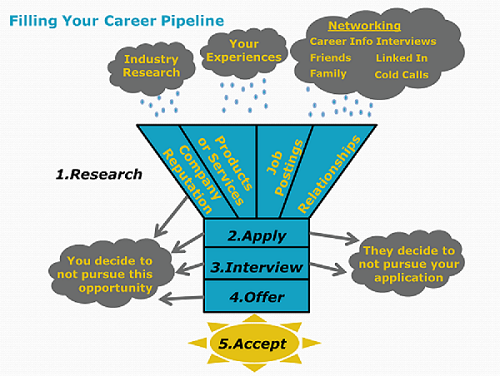 Like any professional service, fees for career coaching can be an issue. The payoff from career coaching is immense. It leads to higher satisfaction, more fulfillment and more pay. If you can afford career coaching, you will find it a worthwhile investment.
Like any professional service, fees for career coaching can be an issue. The payoff from career coaching is immense. It leads to higher satisfaction, more fulfillment and more pay. If you can afford career coaching, you will find it a worthwhile investment.
What if you can’t afford career coaching? If you are a recent college graduate, I recommend using your alma mater’s career center. If you are leaving a company, negotiate for career coaching as part of your outplacement package. You can also check to see what career development services are available from your state or local government.
Whatever you do, don’t settle. Don’t resign yourself to a dead-end job or unemployment. Don’t tolerate a poisonous work situation. Don’t say yes to an unattractive job offer. Pursue your dream job with the dedication of an Olympic hopeful. Fine tune your search skills like a professional golfer on the driving range. And, invest time and money to get the best career coaching you can get.
Faster Change is Your Only Advantage
By Dr. Allen Slade, ACC
In my post on Making Sense of Change, I highlighted the need to devote energy to sense-making during seasons of change. As a leader, how long are your seasons of change? When will things get back to normal?
The rate of change is accelerating. Moore’s Law originally applied to transistors, but the pattern of exponential change affects every process and every corner of your organization. Everything is accelerating – bigger changes, more changes, at a faster pace. Even the pauses are disappearing. When you complete a major change, you are likely to move on to the next change.
Bottom line: Change is the new normal. And your only sustainable competitive advantage is your ability to change faster than the competition.
Your organization’s ability to survive depends on its reflex time. You will prosper as a leader if you are on the front edge of change. And your team needs to get on board with the new normal.
Let’s think through the commitments, competencies and capacities needed for faster change.
Commitment to change. Change is here to stay. Don’t waste energy complaining about the latest change or wishing for past stability. Embrace the change. Look forward to change. Jump into the next challenge.
As a leader in the midst of change, you help set the tone for your team. Be a cheerleader for change. Get others excited about the bright future.
Growing change competence. As change accelerates, you need to be better at change. Treat every change as an opportunity to master new skills. Look for new ways of doing things. Be the first to tackle the new challenge, play with the new system, apply the new concept or talk to the new person. Today’s change is practice for tomorrow.
As a leader, you need to develop your team’s change competence also. Coach them in change competence. Take risks with your team’s decision making – empower them to act without your tight control. Their growth today will make tomorrow’s change easier for both of you.
Capacity to change. It is not enough to be able to change. You need the capacity to change quickly and often. You have to multi-task competing changes. You must accelerate your sense-making so you can quickly climb out of the performance valley of change. And, you cannot rely exclusively on carefully planned change. You need to able to “ready, fire, aim” and just do something.
As a leader, you need to encourage your team’s capacity to change. Push your team to the point of change fatigue. Help them be quicker at sense-making. Get them to move beyond planned change so they can just do something. Then, their change muscles will have more capacity the next time.
You increase competence by mastering new skills. You increase capacity by using those new skills over and over again. I mastered the basic competence of riding a bike many years ago. I recently rode my first century. It was a major challenge to bike a hundred miles in one day. I needed commitment, competence and capacity. I had to commit to finishing the ride. I had to master newer cycling technology – a new road bike instead of my trusty old hybrid, shoes that lock into the pedals and sports drinks that taste like cold sweat. And, most importantly, I had to increase my capacity to go longer and faster by riding hundreds of miles before the actual century.
The demands of change are massive. Dialogue and rest can help you avoid be overwhelmed.
Dialogue. Surround yourself with people who support and encourage you in times of stress.
- Rely on your family members and close friends for encouragement. Talk about your changes. Talk about the impact on you physically, mentally and emotionally.
- Form a circle of trusted advisors with whom you can talk through the challenges and your change approach.
- Consider getting yourself a leadership coach.
Rest. Take a break from the relentless pace of change.
- As needed, stop and catch your breath. Consider using centering or some other activity to still your hands, quiet your mind and calm your heart.
- Schedule times of rest. Every Sunday, I take a sabbatical from work – largely avoiding email, Twitter and this website. I catch up on sleep that day and I think about the big picture. On Monday morning, I am ready to accelerate back onto the change expressway.
As a leader, you must also provide dialogue and rest for your team. If you are pushing them to the point of change fatigue, make sure they recover well. Support them in the midst of change. Talk about the change. Support them with advice. Thank them for their efforts. And, give some breathing room for them to recuperate.
Change is the new normal. The rate of change is accelerating. Your ability to change faster than the competition is your only sustainable competitive advantage. If you are overwhelmed by change, take a quick break right now. Then get a little help from your friends.
Making Sense of Change
By Dr. Allen Slade, ACC
Can you perform at your maximum – can you give 100% – in the midst of change? Should you demand 100% from your team when they are facing change? Pushing hard for short term performance can undermine long term success and maximum growth. We need to leave breathing room for change to work its way out. We need to plan for a season of sense-making.
Meryl Louis defines sense-making as the psychological process of revising our cognitive map to figure out “what is new, different and – particularly – what was unanticipated.” Sense-making rewrites a large cognitive map:
- Understanding new duties, responsibilities, power structures, and peer relationships.
- Clarifying the new path to success, including new performance criteria and new goals.
- Developing new skills and behaviors to master the new role.
Here is a picture of sense-making in action:
When you go through a transition, you should expect a decline in performance. You will need to spend energy and time making sense of the new situation. In the midst of change, I ask my clients two questions:
How deep is your valley? The larger the transition, the deeper the expected decline in performance. A reorganization which just moves some boxes on the org chart will have little impact on your performance. A major change of systems, strategy, structure and culture will require more sense-making.
Where are you on the sense-making curve? The highest level of sense-making tends to occur at the point of transition. The hallway conversations linger longest the day the new strategy is announced. The job change is nested in farewell lunches and new employee orientation programs to give breathing space for sense-making.
When you lead others through change, you should plan for your team’s sense-making. This is tough when the change is triggered by competitive pressure. No matter what the performance demands, you can’t just wish away the need for sense-making. During the change, help your team through the valley. Give them perspective, just-in-time information and support to help move them to the other side.
If change is rolled out top-down, the change leader will be further along the curve. You start planning a change in January and announce the change in April. You will be at the peak of sense-making and stress at the April announcement, but your organization is just starting the process. By August, your performance is almost back to pre-change levels, but your organization is just bottoming out.
This lag in sense-making can cause frustration and impatience. As a leader, you can falsely blame your team for not getting with the program. The reality is they need more time because they started the transition after you.
As a leader, plan for the season of change. Know where your people are. “How deep is their valley?” “Where are they on the sense-making curve?” Truly lead, not just in planning the tasks of change but also in making sense of the new future. Provide perspective, just-in-time information and breathing space to help them climb the far side of the sense-making valley.

